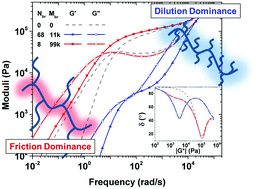Closer insight into the structure of moderate to densely branched comb polymers by combining modelling and linear rheological measurements†
Abstract
Synthesis of combs with well-entangled backbones and long branches with high densities has always been a challenge. Steric hindrance frequently leads to coupling of chains and structural imperfections that cannot be easily distinguished by traditional characterization methods. Research studies have therefore tried to use a combination of different methods to obtain more information on the actual microstructures. In this work, a grafting-from approach is used to synthesize poly(n-butyl acrylate) combs using atom transfer radical polymerization (ATRP) in three steps including the synthesis of a backbone, cleavage of protecting groups and growth of side branches. We have compared the linear viscoelastic properties theoretically predicted by a time marching algorithm (TMA) tube based model with the measured rheological behaviour to provide a better insight into the actual microstructure formed during synthesis. For combs with branches smaller than an entanglement, no discernible hierarchical relaxation can be distinguished, while for those with longer branches, a high frequency plateau made by entangled branches can be separated from backbone's relaxation. Dilution of the backbone, after relaxation of side branches, may accelerate the final relaxation, while extra friction can delay it especially for longer branches. Such a comparison provides a better assessment of the microstructure formed in combs.



 Please wait while we load your content...
Please wait while we load your content...